Abstract
Tyrosinase-positive oculocutaneous albinism (OCA2), an autosomal recessive disorder of the melanin biosynthetic pathway, is the most common recessive disorder occurring in southern African Bantu-speaking Negroids, with an overall prevalence of 1/3,900. The OCA2 gene, P, has been mapped to chromosome 15q11-q13, and recently alterations in the P gene have been identified in OCA2 individuals. An intragenic deletion has been described and proposed to be of African origin because of its occurrence in four unrelated African American OCA2 individuals and in two individuals, one from Zaire and the other from Cameroon. This study shows that the intragenic deletion is a common cause of OCA2 in southern African Negroids (114/146 [.78]; OCA2 chromosomes) and is associated with one common haplotype (43/55 [.78]; OCA2 chromosomes), confirming the African origin of this allele. On the basis of haplotype data, it would appear that at least seven additional, less frequent OCA2 mutations occur in this population.
Full text
PDF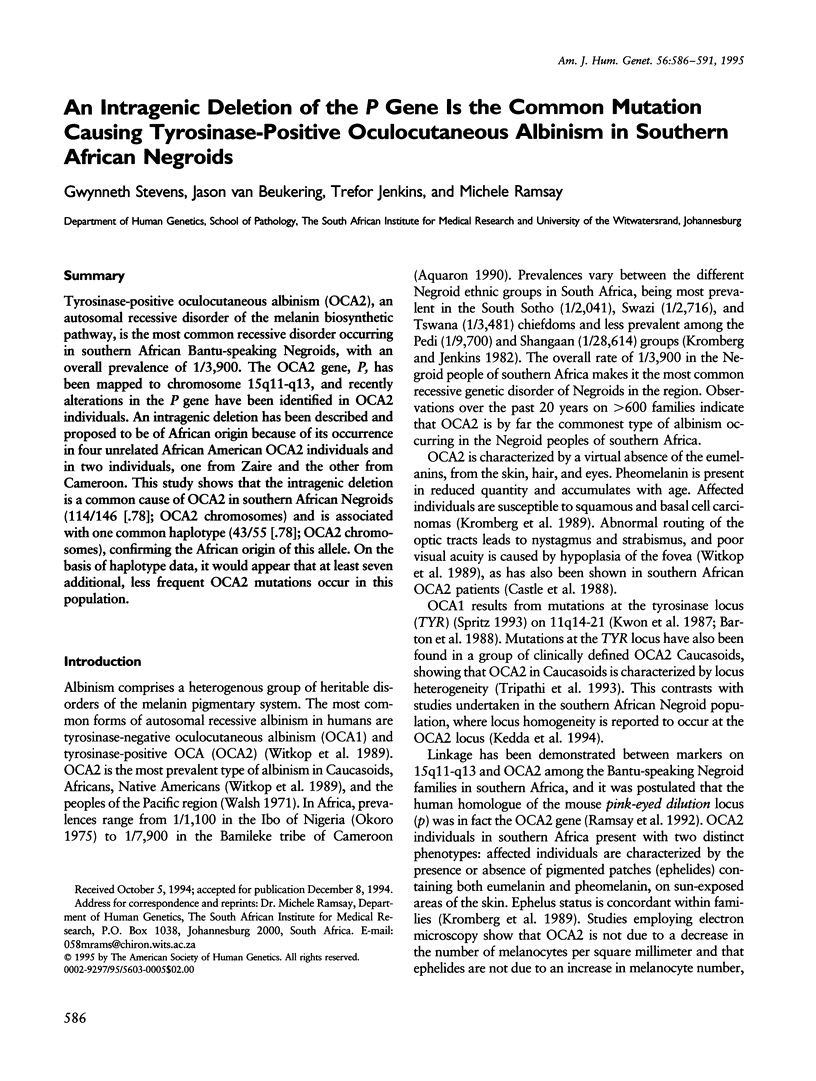
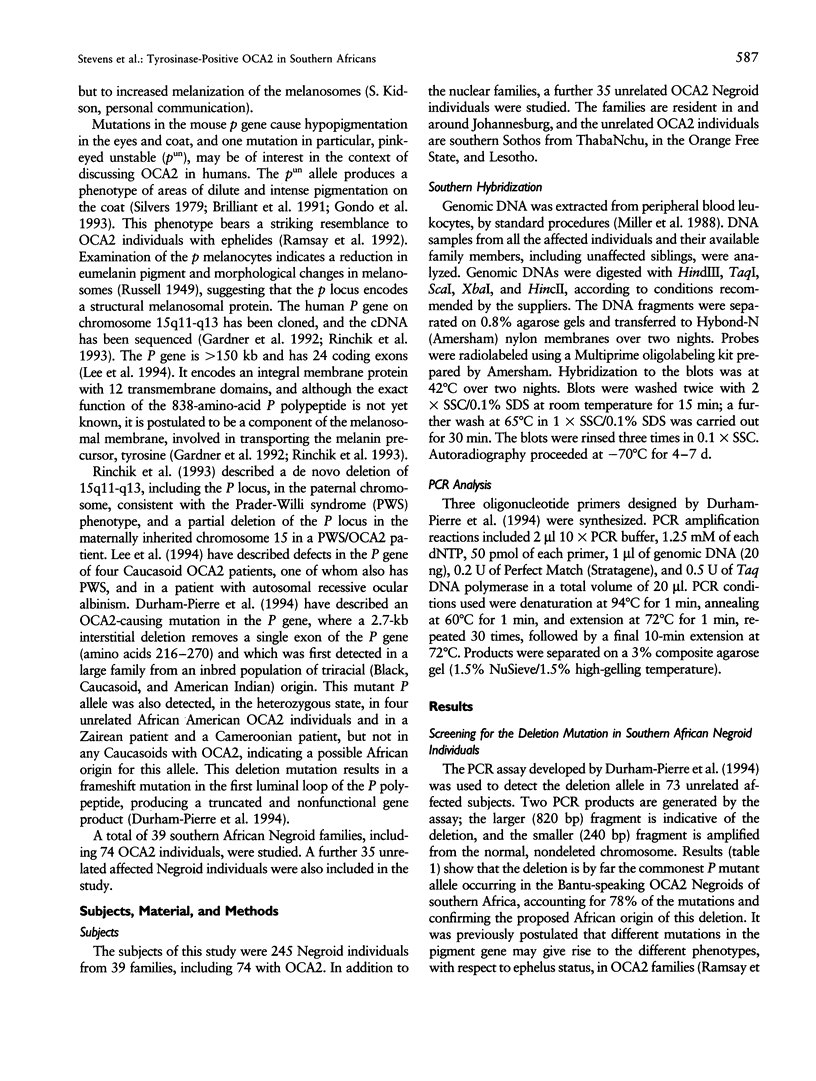
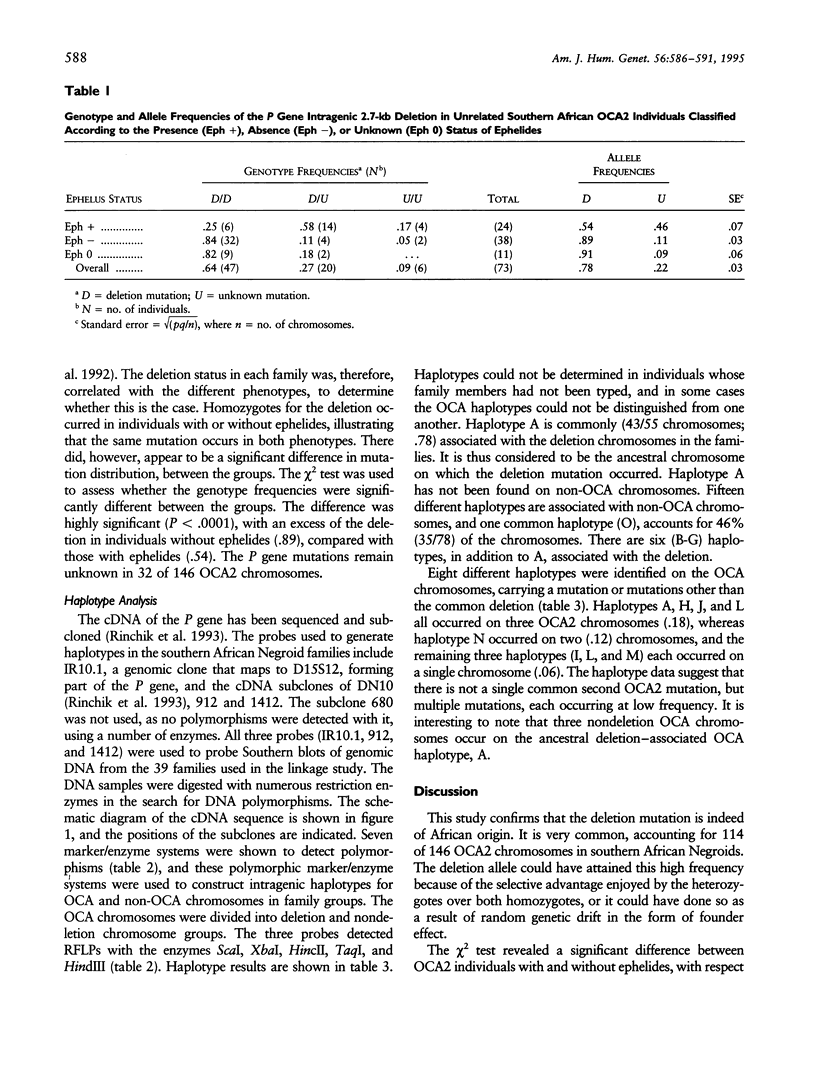
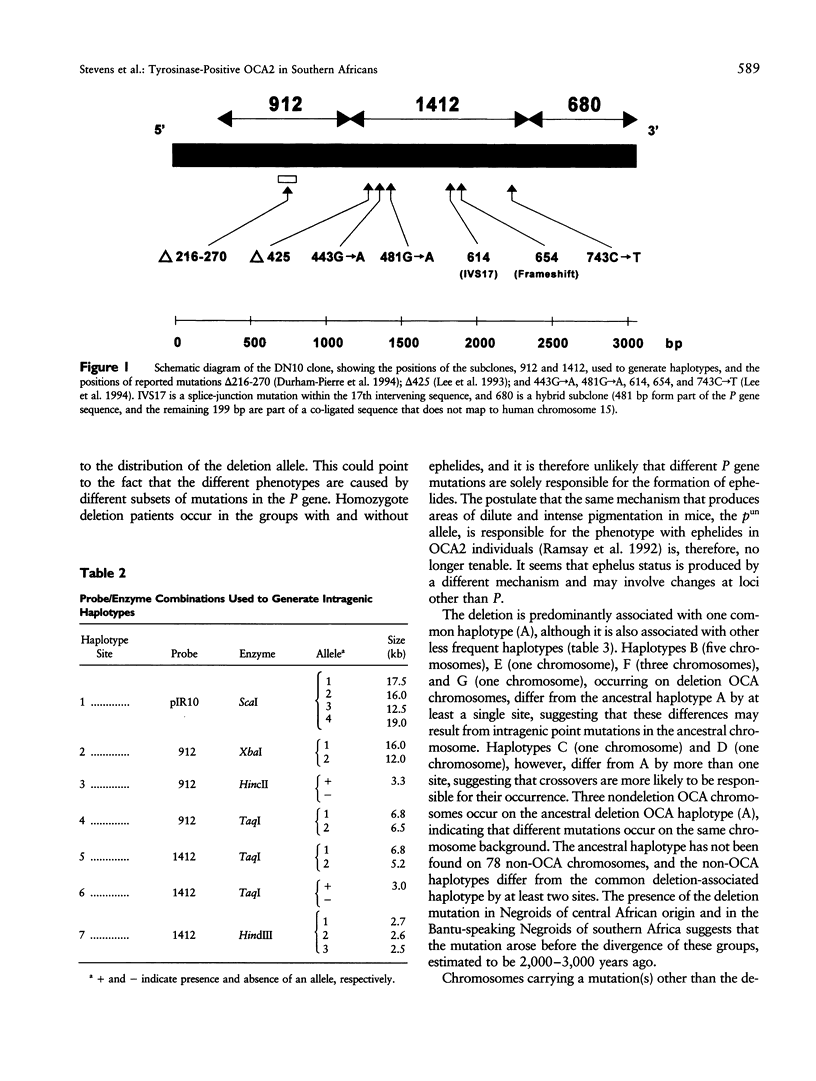
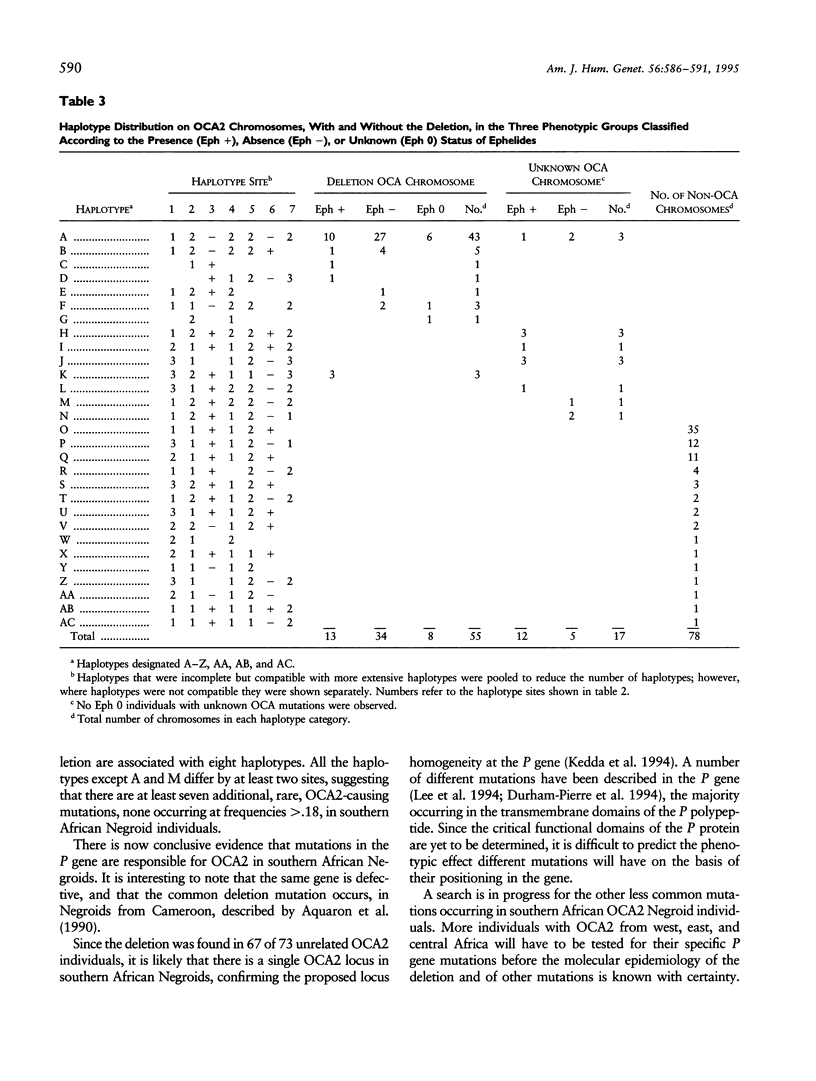
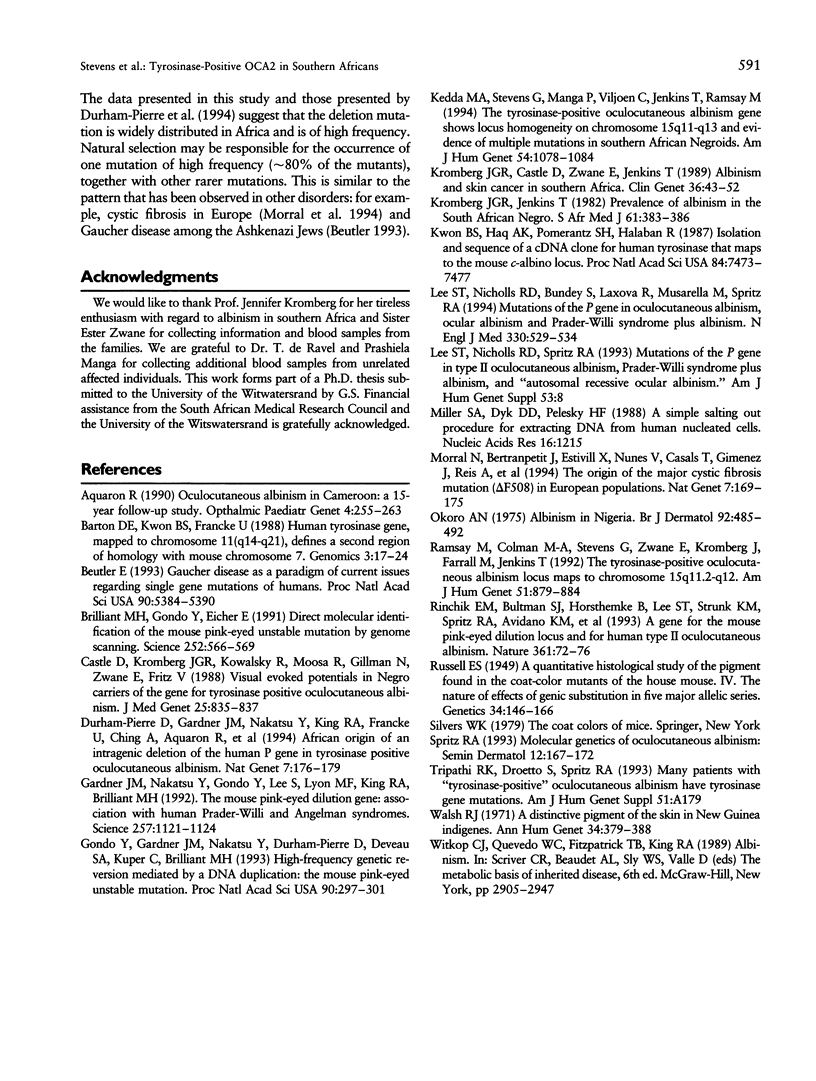
Selected References
These references are in PubMed. This may not be the complete list of references from this article.
- Aquaron R. Oculocutaneous albinism in Cameroon. A 15-year follow-up study. Ophthalmic Paediatr Genet. 1990 Dec;11(4):255–263. doi: 10.3109/13816819009015711. [DOI] [PubMed] [Google Scholar]
- Barton D. E., Kwon B. S., Francke U. Human tyrosinase gene, mapped to chromosome 11 (q14----q21), defines second region of homology with mouse chromosome 7. Genomics. 1988 Jul;3(1):17–24. doi: 10.1016/0888-7543(88)90153-x. [DOI] [PubMed] [Google Scholar]
- Beutler E. Gaucher disease as a paradigm of current issues regarding single gene mutations of humans. Proc Natl Acad Sci U S A. 1993 Jun 15;90(12):5384–5390. doi: 10.1073/pnas.90.12.5384. [DOI] [PMC free article] [PubMed] [Google Scholar]
- Brilliant M. H., Gondo Y., Eicher E. M. Direct molecular identification of the mouse pink-eyed unstable mutation by genome scanning. Science. 1991 Apr 26;252(5005):566–569. doi: 10.1126/science.1673574. [DOI] [PubMed] [Google Scholar]
- Castle D., Kromberg J., Kowalsky R., Moosa R., Gillman N., Zwane E., Fritz V. Visual evoked potentials in Negro carriers of the gene for tyrosinase positive oculocutaneous albinism. J Med Genet. 1988 Dec;25(12):835–837. doi: 10.1136/jmg.25.12.835. [DOI] [PMC free article] [PubMed] [Google Scholar]
- Durham-Pierre D., Gardner J. M., Nakatsu Y., King R. A., Francke U., Ching A., Aquaron R., del Marmol V., Brilliant M. H. African origin of an intragenic deletion of the human P gene in tyrosinase positive oculocutaneous albinism. Nat Genet. 1994 Jun;7(2):176–179. doi: 10.1038/ng0694-176. [DOI] [PubMed] [Google Scholar]
- Gardner J. M., Nakatsu Y., Gondo Y., Lee S., Lyon M. F., King R. A., Brilliant M. H. The mouse pink-eyed dilution gene: association with human Prader-Willi and Angelman syndromes. Science. 1992 Aug 21;257(5073):1121–1124. doi: 10.1126/science.257.5073.1121. [DOI] [PubMed] [Google Scholar]
- Gondo Y., Gardner J. M., Nakatsu Y., Durham-Pierre D., Deveau S. A., Kuper C., Brilliant M. H. High-frequency genetic reversion mediated by a DNA duplication: the mouse pink-eyed unstable mutation. Proc Natl Acad Sci U S A. 1993 Jan 1;90(1):297–301. doi: 10.1073/pnas.90.1.297. [DOI] [PMC free article] [PubMed] [Google Scholar]
- Kedda M. A., Stevens G., Manga P., Viljoen C., Jenkins T., Ramsay M. The tyrosinase-positive oculocutaneous albinism gene shows locus homogeneity on chromosome 15q11-q13 and evidence of multiple mutations in southern African negroids. Am J Hum Genet. 1994 Jun;54(6):1078–1084. [PMC free article] [PubMed] [Google Scholar]
- Kromberg J. G., Castle D., Zwane E. M., Jenkins T. Albinism and skin cancer in Southern Africa. Clin Genet. 1989 Jul;36(1):43–52. doi: 10.1111/j.1399-0004.1989.tb03365.x. [DOI] [PubMed] [Google Scholar]
- Kromberg J. G., Jenkins T. Prevalence of albinism in the South African negro. S Afr Med J. 1982 Mar 13;61(11):383–386. [PubMed] [Google Scholar]
- Kwon B. S., Haq A. K., Pomerantz S. H., Halaban R. Isolation and sequence of a cDNA clone for human tyrosinase that maps at the mouse c-albino locus. Proc Natl Acad Sci U S A. 1987 Nov;84(21):7473–7477. doi: 10.1073/pnas.84.21.7473. [DOI] [PMC free article] [PubMed] [Google Scholar]
- Lee S. T., Nicholls R. D., Bundey S., Laxova R., Musarella M., Spritz R. A. Mutations of the P gene in oculocutaneous albinism, ocular albinism, and Prader-Willi syndrome plus albinism. N Engl J Med. 1994 Feb 24;330(8):529–534. doi: 10.1056/NEJM199402243300803. [DOI] [PubMed] [Google Scholar]
- Miller S. A., Dykes D. D., Polesky H. F. A simple salting out procedure for extracting DNA from human nucleated cells. Nucleic Acids Res. 1988 Feb 11;16(3):1215–1215. doi: 10.1093/nar/16.3.1215. [DOI] [PMC free article] [PubMed] [Google Scholar]
- Morral N., Bertranpetit J., Estivill X., Nunes V., Casals T., Giménez J., Reis A., Varon-Mateeva R., Macek M., Jr, Kalaydjieva L. The origin of the major cystic fibrosis mutation (delta F508) in European populations. Nat Genet. 1994 Jun;7(2):169–175. doi: 10.1038/ng0694-169. [DOI] [PubMed] [Google Scholar]
- Okoro A. N. Albinism in Nigeria. A clinical and social study. Br J Dermatol. 1975 May;92(5):485–492. [PubMed] [Google Scholar]
- Ramsay M., Colman M. A., Stevens G., Zwane E., Kromberg J., Farrall M., Jenkins T. The tyrosinase-positive oculocutaneous albinism locus maps to chromosome 15q11.2-q12. Am J Hum Genet. 1992 Oct;51(4):879–884. [PMC free article] [PubMed] [Google Scholar]
- Rinchik E. M., Bultman S. J., Horsthemke B., Lee S. T., Strunk K. M., Spritz R. A., Avidano K. M., Jong M. T., Nicholls R. D. A gene for the mouse pink-eyed dilution locus and for human type II oculocutaneous albinism. Nature. 1993 Jan 7;361(6407):72–76. doi: 10.1038/361072a0. [DOI] [PubMed] [Google Scholar]
- Russell E S. A Quantitative Histological Study of the Pigment Found in the Coat-Color Mutants of the House Mouse. IV. the Nature of the Effects of Genic Substitution in Five Major Allelic Series. Genetics. 1949 Mar;34(2):146–166. doi: 10.1093/genetics/34.2.146. [DOI] [PMC free article] [PubMed] [Google Scholar]
- Spritz R. A. Molecular genetics of oculocutaneous albinism. Semin Dermatol. 1993 Sep;12(3):167–172. [PubMed] [Google Scholar]
- Walsh R. J. A distinctive pigment of the skin in New Guinea indigenes. Ann Hum Genet. 1971 May;34(4):379–388. doi: 10.1111/j.1469-1809.1971.tb00250.x. [DOI] [PubMed] [Google Scholar]


